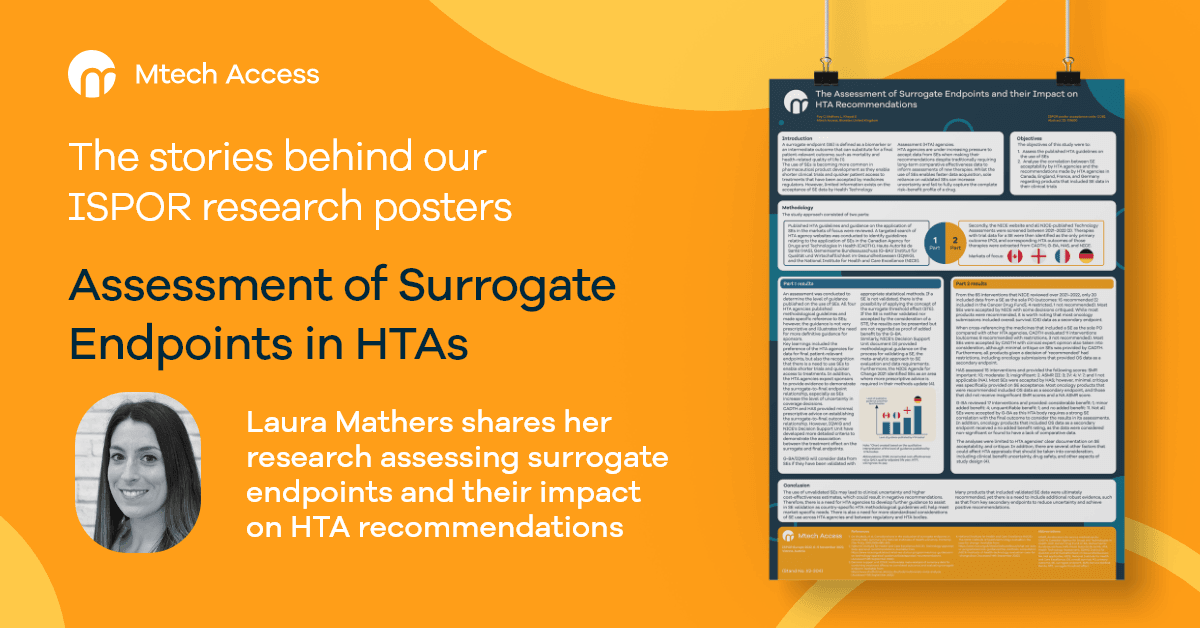
We speak to Laura Mathers (Senior Analyst – Market Access) to get the story behind the poster: ‘The Assessment of Surrogate Endpoints and Their Impact on HTA Recommendations’. Laura worked with Clare Foy (Director -Global Market Access) and Edgar Khayat, to research, develop and co-author the poster for presentation at ISPOR.
In all, we presented seven independent research posters at ISPOR Europe, from 7th–9th November 2022. In this series of interviews we sit down with poster authors to learn a bit more about their research.

What research question does your poster explore?
Our poster is titled ‘The Assessment of Surrogate Endpoints and their Impact on HTA Recommendations’. In other words, we were looking to understand how HTA agencies make decisions about products that have surrogate endpoint data. Surrogate endpoints can be a laboratory measurement or a physical sign that can be used as a substitute for a clinically meaningful endpoint that measures directly how a patient feels, functions or survives. Surrogate endpoints are used in clinical trials because results can often be measured more quickly than waiting for hard clinical endpoints, resulting in earlier HTA assessment and approval of drugs.
What inspired you to pursue this topic?
We decided to pursue this topic after researching HTA methodological guidelines to determine their acceptance of surrogate endpoints as a primary endpoint.
We found it interesting that HTA markets varied in their documented acceptance of data from surrogate endpoints as part of the evidence package. Therefore, we wanted to identify the correlation between surrogate endpoint acceptability by HTA bodies and the recommendations awarded by those HTA bodies.
How did you and your co-writers work together to conduct the research and develop the poster?
As part of our work for a client company, we had previously investigated HTA methodological guidelines to determine the acceptance of surrogate endpoints as a primary endpoint. This proved a really interesting topic and piqued our interest to take the research further. From there, we decided which markets we were most interested in to identify a correlation between surrogate endpoints and HTA recommendations. This resulted in us looking at CADTH, NICE, HAS, and G-BA HTA decisions.
The NICE website and all Technology Assessments published by NICE between 2021–2022 were screened. Therapies with trial data for a surrogate endpoint as the only primary outcome and their corresponding HTA outcomes were extracted. We then searched for reviews of these therapies by CADTH, G-BA, and HAS, and extracted their HTA outcomes. All results were then compared to identify differences between HTA bodies and their acceptance of the use of surrogate endpoints.
For you, what was the most interesting aspect of your research?
I found it interesting that the acceptance of surrogate endpoints and the detail of methodological guidelines differed between HTA bodies. More definitive guidance is needed for sponsors, along with clearer documentation in HTA decision making. Currently it is difficult to determine whether surrogate endpoints will be accepted by specific HTA bodies and whether alternative options need to be explored.
Were the results as you anticipated when you began your research?
I expected to find more detailed documentation around the acceptance or non-acceptance of surrogate endpoints in HTA decisions. These weren’t always provided by HTA bodies.
What was your most important conclusion?
The use of surrogate endpoints as primary endpoints is becoming more common in clinical trials, and it’s important to continue to keep up to date with any methodological guideline updates that HTA bodies may develop in the future.
In addition, our interpretation is only based on what was documented. Acceptance or non-acceptance of surrogate endpoints may have been taken into further consideration than those documented, and other factors such as clinical benefit uncertainty, drug safety, and other aspects of study design could also have impacted HTA recommendations.
What’s the next step for your research?
It would be interesting to investigate surrogate endpoint acceptance and methodological guidance in other markets such as Australia, another mature HTA market, and the US, a as a diverse multi-stakeholder market.
What have you learnt that you can apply to future research?
We hope our findings highlight the need for clearer guidance from regulators about how companies can use surrogate endpoint data effectively so that patient-centric reimbursement decisions can be made. We also acknowledge that there is a need to validate surrogate endpoints, and we have experience in that from other client project work. We hope to conduct further work in this area to add to the body of research in the field.
View the poster here.
If you would like to discuss this research with the poster authors or to learn more about how we can support you with market access strategy and/or health technology assessment, email info@mtechaccess.co.uk.


